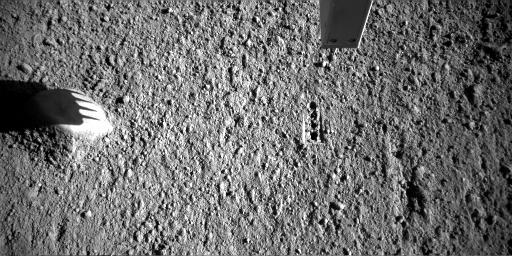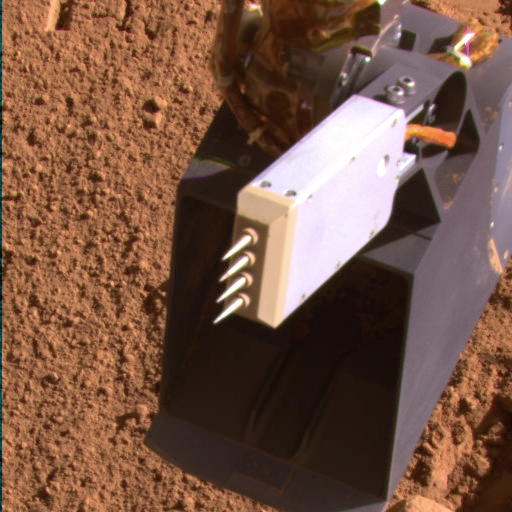[/caption]
NASA’s Phoenix Mars Lander has a fork-like conductivity probe on it’s robotic arm, and results from the instrument are presenting a bit of a quandary for mission scientists. The thermal and electroconductivity probe has sensed humidity rising and falling in the air the near the lander, but when stuck into the ground, its measurements so far indicate soil that is thoroughly and perplexingly dry. “If you have water vapor in the air, every surface exposed to that air will have water molecules adhere to it that are somewhat mobile, even at temperatures well below freezing,” said Aaron Zent, lead scientist for the probe. While Phoenix has other tools to find clues about whether water ice at the site has melted in the past, the conductivity probe is the main tool for checking for present-day soil moisture.
Preliminary results from the latest insertion of the probe’s four needles into the ground, on Wednesday and Thursday, match results from the three similar insertions in the three months since landing. “All the measurements we’ve made so far are consistent with extremely dry soil,” Zent said. “There are no indications of thin films of moisture, and this is puzzling.”
In below-freezing permafrost terrains on Earth, that thin layer of unfrozen water molecules on soil particles can grow thick enough to support microbial life. One goal for building the conductivity probe and sending it to Mars has been to see whether the permafrost terrain of the Martian arctic has detectable thin films of unfrozen water on soil particles. By gauging how electricity moves through the soil from one prong to another, the probe can detect films of water barely more than one molecule thick.

Three other sets of observations by Phoenix, in addition to the terrestrial permafrost analogy, give reasons for expecting to find thin-film moisture in the soil.
One is the conductivity probe’s own measurements of relative humidity when the probe is held up in the air. “The relative humidity transitions from near zero to near 100 percent with every day-night cycle, which suggests there’s a lot of moisture moving in and out of the soil,” Zent said.
Another is Phoenix’s confirmation of a hard layer containing water-ice about 5 centimeters (2 inches) or so beneath the surface.
Also, handling the site’s soil with the scoop on Phoenix’s robotic arm and observing the disturbed soil show that it has clumping cohesiveness when first scooped up and that this cohesiveness decreases after the scooped soil sits exposed to air for a day or two. One possible explanation for those observations could be thin-film moisture in the ground.
The Phoenix team is laying plans for a variation on the experiment of inserting the conductivity probe into the soil. The four successful insertions so far have all been into an undisturbed soil surface. The planned variation is to scoop away some soil first, so the inserted needles will reach closer to the subsurface ice layer.
“There should be some amount of unfrozen water attached to the surface of soil particles above the ice,” Zent said. “It may be too little to detect, but we haven’t finished looking yet.”
Source: Phoenix News


Oh, brother! BAck to the wishy-washy boloney!
I can’t believe this.
Heh. When I heard about the ‘clumpiness’ of the soil and the problems it made for TEGA, I wondered if it was moisture films. So this is really interesting – a real puzzle for the scientists.
Sounds like a question that could be solved in 15 minutes by a man with a shovel.
Yes, but the hard part would be getting the man their. Don’t get me wrong ,I want to see a manned mission to Alpha Centauri before I kick the bucket, but it doesn’t seem likely at this rate and fundage.
it is definitely interesting …i was wondering whether it could be that the soil is highly oxidising and hence water is lost as soon as it is absorbed or could it contain minerals which are hydrophobic on the surface?…
loads of speculation…but answers are not far , i am sure,
Good Luck Phoenix….
Martian Water = Schroedinger’s Water?
If ice directly sublimates on mars, wouldn’t that effect water forming?
I’m not a chemist, but unless the probe is more than 3 inches long (based on where their digs were turning up frozen material), this is pretty much the results I would expect.
Think they will get better results if they do a quick “Dig then stick”. Try it during different times of day as well.
I thought we saw pictures of H2O frost some days ago – if not, we’ll see it very soon. So there is at times water ice on the surface, then it sublimes away (like was mentioned previously). So I don’t really see the problem or mystery in these measurements. The top layer of soil is very dry – if there was moisture there, not bound to the soil, it would also sublime away. Right?
I wish we had more sequence photos of how the exposed ice changes with time.
Life has to exist before it can adapt… I do not understand why the general thinking is that life here on earth that has adapted to the harshes conditions on this planet has anything to do with life “originating” elsewhere. We simply do not fully understand the conditions needed to originate life, but it seems we do understand what conditions life can adapt to, which we then confuse with the what is needed for life to begin!
this is indeed perpexing: Conductivity probes are extremely sensitive to changes in moisture content if not to-and-from the regoth, whats happening?
It is worth noting that the plasma sheath did not interupt communications during entry as expected.
Is mars unwilling to share electrons with us?
1) Mars Regolith is extremely dry but surprisingly clumpy. The stickiness could be due to charged particles as was experienced in Moon. Are we sure that the conductivity probe works well under highly static and charged conditions? The readings could be misleading for this reason.
2) The regolith is extremely dry and just two inches in thickness and that will not create enough pressure to have a liquid film of water at just 2 inches depth. The whole exercise of inserting the conductivity probe, whether on undisturbed soil or after scooping a few inches may not help in finding water moistened regolith with high conductivity.
3) Now we know for sure that under the 2-inch layer of regolith there lies hard sheet of ice. How could the sheet of ice form in the first place? There is no liquid state of water to seep through from the regolith top – not under the current conditions. The sheet of ice is therefore pristine, from a distant past. The regolith and the sheet of ice are two separate layers, the former protecting the sublimation but the two do not naturally mix with each other, except when we scooped and exposed some chunks of white material.
4) If we have to find liquid film of water mixed with regolith we have to go deeper – by a few meters so that pressure is enough to support liquid state of water.
5) Coming to formation of frost and its sublimation cycle witnessed everyday, the frost simply sits over the regolith without mixing with it as liquid water on the surface never exists. Not even a drop of it would possibly ever seep through to the subsurface ice sheet.
Considering above I wonder why are the scientists so baffled with the conductivity tests?
Essel – wouldn’t the water vapor, as conditions change to compel the formation of frost, occur within the soil also? At some depth, the insolation of the soil would prevent sublimation of the frost – the ice would accumulate. Wouldn’t this be why the the ice layers form? I don’t think that a necessary conclusion is that the ice layers have existed since a “pristine, distant past”. Very interesting.
Essel’s comments are the most noteworthy.
Umm, perhaps this is nit-picking, but the possessive pronoun “its” in the first sentence of this story should not contain an apostrophe. Flame me if you must, but shouldn’t people who purport to be writers know better?
Just trying to keep our language from deteriorating any faster than it has to.
I can never keep the contraction and possessive straight either. I even have a Post-It note in my dictionary on that page!
I agree that we all must set a good example to maintain English grammar, spelling, and punctuation on the Internet.
That being said I know I have to be more vigilant.
I wonder whether tests on earth with similar air pressure and without any life have been done.
In our environments life is very good in making films wherever small amounts of water exist. Pure water does not conduct electricity very well, though.
ID Skeptic…
I would consider the structure of your last sentence worse than the improper use of a contraction. Separating a statement sentence and a question sentence with a conjunction… tsk tsk. Even a semi-coon would be improper.
Lighten up …. this is a BLOG. The main purpose is to promote discussion and learning..INFORMALLY (one more time for the hard-headed…. INFORMALLY)!
Each article contains a source of information. Go there for specifics and proper grammar, or perhaps find your way to a journalism blog.
@Occupant
I don’t mean to belittle the obstacles that we have to defeat in order to land men on the moon. My comment was more a knock against those who put their faith entirely in robots.
One of the reasons I suspect we don’t see more robust funding for manned missions is because the folks who control the purse strings have been convinced we can do it all through unmanned programs… but its becoming obvious we can’t.
We’re having trouble with even the simple stuff.
Maxwell are you new to this whole space thing?
Everyone would like a manned mission to Mars, and the reason there hasn’t been one yet has nothing to do with funding. It isn’t like we can just point the Space Shuttle towards Mars and light up the engines.
Don’t go around knocking anybody unless you can do something better, and it is obvious you couldn’t. You still need to grasp how decisions on missions and funding are made at NASA.
THAT”S IT….. Slipher and the early astronomers also saw the early morning frost, so I went back and checked Slipher’s book (Mars, the Photographic Story, 1962). “The glint of these objects (white patches), their resemblence to the snow cap, the time and place of their occurrence, and their behavior have led to the conclusions that they are patches of morning frost….(which) showed a stong preponderance for the light regions and rarely appeared appeared over dark regions.” So, since Phoenix is in a “light” region why doesn’t it darken as some other areas on Mars? – the answer might be that climate at that spot doesn’t allow enough moisture to form in the spaces between the soil….it is very, very, very dry. Too dry for even hardy Martian life. There might be some spores in the soil, but they never get activated by water. In fact Slipher and the other early astronomers have observed areas of traditionally “desert” color to change to the dark-green shade (in 1954, I think). Perhaps Phoenix microscope will show a spore afer all….. which would be a big kick to the PC game that just got released…..hopefully this is the ending to the my first book and the beginning of a new chapter of science!
For all you who prefer to ridicule the observations of the early astronomers – mock away.
Yet another inconclusive report from an instrument. What have we learned, kiddies?
Mars ain’t Earth.